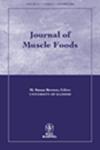The objective of this study was to identify differences in rate and extent of postmortem tenderization between sire lines and determine correlations between changes in tenderness and other quality traits in pork. Pigs from eight sire lines were raised in a single production facility and harvested on a single day. Whole bone-in loins (n = 151) were collected for fabrication and further analysis. Quality measurements were performed 24 h postmortem and chops were aged 2, 7, 14 and 21 days postmortem for analysis of Warner-Bratzler shear force. Shear force did not differ (P > 0.10) between sire lines at any day of aging; however, rate and extent of postmortem tenderization were different (P < 0.05) between sire lines. While correlations (P < 0.05) between shear force and marbling, loin fat content and water-holding capacity traits were found, correlations were not significant (P > 0.05) for more easily measured quality traits of ultimate pH or color.
Consumers often denote tenderness as the most important trait in determining the overall quality of pork. Predicting tenderness, however, can be very challenging because many preharvest and postharvest factors influence this trait. Furthermore, tenderness changes with postmortem storage, a phenomenon that is also difficult to predict. This work correlates meat quality traits with both ultimate shear force and the change in shear force with storage. While shear force and the change in shear force are correlated with some quality traits such as water-holding capacity, no one easily measurable trait strongly correlated with shear force. Therefore, this research provides only the first steps in being able to predict tenderness in pork. Furthermore, this work indicates that not all pork ages similarly – the rate and extent of change in postmortem tenderness can be impacted by sire line. These differences between sire lines may offer a new angle of marketing pork.


